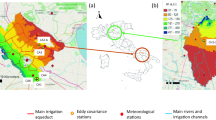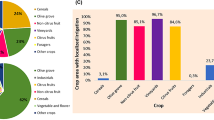Abstract
Over the past decade in Australia, there has been a general trend towards the introduction of electrical motors to operate irrigation pumps. While electrical motors provide many advantages over the alternatives, electrical loads can aggregate in some areas to become large peaks, which challenge the existing electrical distribution networks. This is especially true during extreme hot or dry periods, when irrigators collectively demand significant electrical resources at the same time. While there is an inherent link between weather conditions and the amount of electricity used for irrigation, this relationship is poorly understood. Previous studies have either focused on localised data related to concurrent temperature, rainfall and soil moisture, or they have annualised summaries over large areas. In this study, we compare intensive irrigation periods with the drought factor at a case study irrigation scheme in Tasmania, Australia, finding a strong relationship between electrical load and periods when the drought factor is > 6. This relatively simple relationship may be useful for managers of electricity supply and distribution, managers of water resources, and irrigators, as it may be used to minimise the risk of exceeding the capacity of the electricity network, improve water availability and optimise irrigation scheduling.







Similar content being viewed by others
References
Addink J, Addink S (2003) Agricultural irrigation schedules based on evapotranspiration. WIPO 2003081362:A1. World Patent, filed March 21, 2002, and issued October 2, 2003
AgInnovators (2017) Water and energy. AgInnovators, St Leonards, Australia. http://aginnovators.org.au/initiatives/energy/themes/water-and-energy. Accessed 14 Jan 2017
Alfaro EJ, Pierce DW, Steinemann AC, Gershunov A (2005) Relationships between the irrigation-pum** electrical loads and the local climate in Climate Division 9, Idaho. J Appl Meteorol 44(12):1972–1978
Allen RG, Pereira LS, Raes D, Smith M (1998) Crop evapotranspiration: guidelines for computing crop water requirements. Irrigation and drainage Paper No. 56, food and agricultural organization of the United Nations (FAO), Rome
Bartos MD, Chester MV (2015) Impacts of climate change on electric power supply in the Western United States. Nat Clim Change 5:748–752. https://doi.org/10.1038/nclimate2648
Bos MG, Kselik RAL, Allen RA, Molden D (2009) Water requirements for irrigation and the environment. Springer, New York
Bureau of Meteorology (2017) Climate data online. Bureau of Meteorology, Melbourne, Australia. http://www.bom.gov.au/climate/data/. Accessed 11 Feb 2017
CSIRO (2009) Water availability for tasmania. Report to the Australian Government from the CSIRO Tasmania Sustainable Yields Project. CSIRO Water for a Healthy Country Flagship, Australia. https://doi.org/10.4225/08/58557f4317516
Döll P (2002) Impact of climate change and variability on irrigation requirements: a global perspective. Clim Change 54(3):269–293
Doulgeris C, Georgiou P, Papadimos D, Papamichail D (2015) Water allocation under deficit irrigation using MIKE BASIN model for the mitigation of climate change. Irrig Sci 33:469. https://doi.org/10.1007/s00271-015-0482-4
Dubus L (2010) Practices, needs and impediments in the use of weather/climate information in the electricity sector. In: Troccoli A (ed) Management of weather and climate risk in the energy industry. NATO science for peace and security series C: environmental security. Springer, Dordrecht, pp175–188
Evans R, Sneed R, Hunt JH (1996) Irrigation management strategies to improve water and energy use efficiencies. North Carolina Cooperative Extension Service, Raleigh
FAO (2017) AQUASTAT—FAO’s information system on water and agriculture. Food and Agriculture Organization of the United Nations. http://www.fao.org/nr/water/aquastat/didyouknow/index3.stm. Accessed 15 Feb 2017
Fernández García I, Montesinos P, Camacho Poyato E, Rodríguez Díaz A (2016) Energy cost optimization in pressurized irrigation networks. Irrig Sci 34:1–13
Finkele K, Mills GA, Beard G, Jones DA (2006) National gridded drought factors and comparison of two soil moisture deficit formulations used in prediction of forest fire danger index in Australia. Aust Meteorol Mag 55:183–197
García-Tejero IF, Durán-Zuazo VH, Muriel-Fernández JL, Rodríguez-Pleguezuelo CR (2011) Water and sustainable agriculture. Springer, New York
Gellings CW (2009) Energy efficiency in pum** and irrigation systems. In: Gellings CW (ed) Efficient use conservation of energy, vol 2. EOLSS Publishers, Paris
Georgiou PE, Papamichail DM (2008) Optimization model of an irrigation reservoir for water allocation and crop planning under various weather conditions. Irrig Sci 26:487–504. https://doi.org/10.1007/s00271-008-0110-7
Gleick PH (2003) Water use. Annu Rev Environ Resour. http://annualreviews.org/doi/full/10.1146/annurev.energy.28.040202.122849. Accessed 15 Mar 2017
Griffiths D (1999) Improved formula for the drought factor in McArthur’s Forest Fire Danger Meter. Aust For 62(2):202–206
Grolemund G, Wickham H (2011) Dates and times made easy with lubridate. J Stat Softw 40(3):1–25
Grose MR, Barnes-Keoghan I, Corney SP, White CJ, Holz GK, Bennett JB, Gaynor SM, Bindoff NL (2010) Climate futures for Tasmania: general climate impacts technical report. Antarctic Climate and Ecosystems Cooperative Research Centre, Hobart
Guerra LC, Hoogenboom G, Hook JE, Thomas DL, Boken VK, Harrison KA (2005) Evaluation of on-farm irrigation applications using the simulation model EPIC. Irrig Sci 23:171–181. https://doi.org/10.1007/s00271-005-0105-6
Henningsen A, Toomet O (2013) miscTools: miscellaneous tools and utilities. R Package Version 0.6-16. https://CRAN.R-project.org/package=miscTools. Accessed 16 Feb 2017
Intergovernmental Panel on Climate Change (2013) Summary for Policymakers. In: Stocker TF, Qin D, Plattner GK, Tignor M, Allen SK, Boschung J, Nauels A, **a Y, Bex V, Midgley PM (eds) Climate Change 2013: The Physical Science Basis. Contribution of Working Group I to the Fifth Assessment Report of the Intergovernmental Panel on Climate Change. Cambridge University Press, Cambridge, United Kingdom and New York, NY, USA
Irrigation Australia (2017) History of irrigation. Irrigation Australia, Mascot, Australia. https://www.irrigationaustralia.com.au/about-us/the-history-of-irrigation. Accessed 21 Feb 2017
Leenhardt D, Trouvat J-L, Gonzalès G, Pérarnaud V, Prats S, Bergez J-E (2004a) Estimating irrigation demand for water management on a regional scale: I. ADEAUMIS, a simulation platform based on bio-decisional modelling and spatial information. Agric Water Manag 68:207–232. https://doi.org/10.1016/j.agwat.2004.04.004
Leenhardt D, Trouvat J-L, Gonzalès G, Pérarnaud V, Prats S, Bergez J-E (2004b) Estimating irrigation demand for water management on a regional scale: II. Validation of ADEAUMIS. Agric Water Manag 68:233–250. https://doi.org/10.1016/j.agwat.2004.04.003
Meander Valley Council (2013) Importance of agriculture. Meander Valley Council, Deloraine
Mount AB (1972) The derivation and testing of a soil dryness index: using run-off data. Forestry Commission of Tasmania, Hobart
NPSI (2012) Irrigation essentials updated. http://www.insidecotton.com/xmlui/bitstream/handle/1/1954/npsi06121-irrigation-essentials-updated.pdf?sequence=3&isAllowed=y. Accessed 26 Feb 2017
Peck DE, Peterson JM (2013) Introduction to the special issue on ‘Climate variability and water-dependent sectors: impacts and potential adaptations’. J Nat Resour Rolicy Res 5(2–3):73–77
R Team (2017) R: the R Project for statistical computing. http://www.R-project.org. Accessed 16 Feb 2017
Roth G (2012) Irrigation in Australia facts and figures. http://www.nswic.org.au/pdf/irrigation_statistics/Facts%20Figures.pdf. Accessed 16 Feb 2017
RStudio Team (2015) RStudio: integrated development for R. RStudio. http://www.rstudio.com/. Accessed 16 Feb 2017
Schiermeier Q (2015) Quest for climate-proof farms. Nature 523(7561):396
Shorten P, Rostron L, Eyre D, Flores G (2014) Electricity or diesel for irrigation pum** the key energy consideration at a mixed-farm enterprise. Farm Energy Innovation Program (EEIG), NSW Farmers Association, St Leonards, NSW, Australia
Stark GL, Stetson LE (1985) Comparison of farmstead, irrigation, and residential demands on rural feeders in Central Nebraska. Trans Am Soc Agric Eng 28(5):1657–1663
Stetson LE, Addink JW (1977) Controlling peak electrical demands by scheduling irrigation systems. Trans Am Soc Agric Eng 20(4):0754–0757
Tasmanian Institute of Agriculture (2017) Irrigation in Tasmania. Tasmanian Institute of Agriculture, University of Tasmania, Hobart, TAS, Australia. http://www.utas.edu.au/tia/centres/irrigation/irrigation-in-tasmania/irrigation-in-tasmania2. Accessed 21 Feb 2017
TasNetworks (2015) TasNetworks corporate plan. Tasmanian Networks Pty Ltd, Hobart
Tuszynski J (2014) caTools: tools: moving window statistics, GIF, Base64, ROC AUC, Etc.. R Package Version 1.17.1. https://CRAN.R-project.org/package=caTools. Accessed 5 Jun 2016
Wickham H (2016) Readxl: read excel files. R Package Version 0.1.1. https://CRAN.R-project.org/package=readxl. Accessed 10 Apr 2016
Wickham H, Francois R (2016) Dplyr: a grammar of data manipulation. R Package Version 0.5.0. https://CRAN.R-project.org/package=dplyr. Accessed 18 Jan 2017
Wood SN (2006) Generalized additive models: an introduction with R, vol 66. CRC Press, Boca Raton
Wood SN (2011) Fast stable restricted maximum likelihood and marginal likelihood estimation of semiparametric generalized linear models. J R Stat Soc B 73:3–36. https://doi.org/10.1111/j.1467-9868.2010.00749.x
Acknowledgements
This study was supported by a Dean’s Summer Research Scholarship from the Faculty of Science, Engineering and Technology at the University of Tasmania. The authors wish to acknowledge the generous support of Paul Fox-Hughes, Bureau of Meteorology, Mike O’Shea, Tasmanian Irrigation, and Chong Ong, TasNetworks, for the provision of data and comments during the preparation of the manuscript.
Author information
Authors and Affiliations
Corresponding author
Additional information
Communicated by E. Fereres.
Rights and permissions
About this article
Cite this article
Latham, T., White, C.J. & Remenyi, T.A. The relationship between irrigation-induced electrical loads and antecedent weather conditions in Tasmania, Australia. Irrig Sci 36, 167–178 (2018). https://doi.org/10.1007/s00271-018-0573-0
Received:
Accepted:
Published:
Issue Date:
DOI: https://doi.org/10.1007/s00271-018-0573-0




